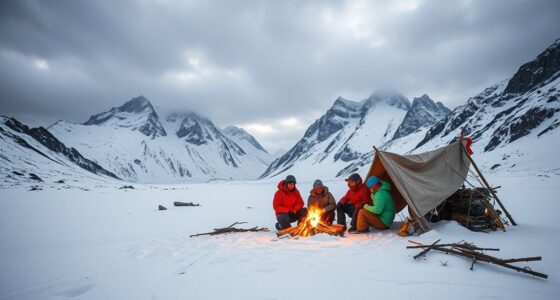Basic wilderness first aid involves knowing how to handle injuries like cuts, burns, and splinters when professional help may be hours away. You should stock a well-prepared kit, learn how to clean wounds, stop bleeding, and immobilize broken bones. Prevent injuries by planning ahead and staying alert to hazards. Mastering these skills enables you to provide vital care, stabilize the injured, and guarantee safety until help arrives—discover more ways to stay prepared and confident out in the wilderness.
Key Takeaways
- Carry a well-stocked first aid kit with essentials like bandages, antiseptics, and pain relievers for immediate injury treatment.
- Use proper techniques, such as cleaning wounds and applying pressure, to prevent infection and control bleeding.
- Assess the scene carefully, ensure safety, and provide stabilization until professional help arrives.
- Prevent injuries by planning routes, wearing appropriate gear, and staying alert to environmental hazards.
- Stay calm, familiarize yourself with basic first aid procedures, and manage the scene effectively during emergencies.

When you’re out in the wilderness, knowing basic first aid can be the difference between a minor setback and a life-threatening situation. Emergencies can strike unexpectedly, whether it’s a cut, a burn, or a sudden illness, so being prepared with the right knowledge and tools is essential. One of the first steps in outdoor safety is ensuring you have a well-stocked first aid kit. This kit should include essentials like bandages, antiseptic wipes, tweezers, pain relievers, and any personal medications. Having these supplies on hand means you can treat minor injuries immediately, reducing the risk of infection or worsening conditions.
Being prepared with a well-stocked first aid kit is crucial for wilderness emergencies.
A good first aid kit isn’t just about having the right supplies; it’s also about knowing how to use them. When you’re in a remote location, professional medical help might be hours away, so your ability to perform basic procedures can be lifesaving. For example, if someone gets a splinter, you’ll need tweezers to carefully remove it without pushing it deeper. For cuts and scrapes, clean and cover the wound with sterile bandages to prevent infection. Knowing how to stop bleeding with pressure or elevate a broken limb can make a huge difference before professional help arrives.
Outdoor safety also involves understanding how to prevent injuries in the first place. Always plan ahead by checking weather conditions, informing someone about your route, and carrying enough supplies, including your first aid kit. It’s wise to carry extra supplies if you’re venturing into more isolated areas. Additionally, wearing appropriate clothing and footwear can prevent blisters, scrapes, and other minor injuries. Staying alert to your surroundings helps you avoid hazards like sharp rocks, thorny bushes, or unstable terrain.
In an emergency, your calmness and quick thinking matter most. Assess the situation carefully before acting. If someone is injured, check for responsiveness, and call for help if necessary. While waiting, provide first aid from your kit—clean wounds, immobilize broken bones, and keep the injured person warm. Properly managing the scene reduces the chance of further harm and ensures the injured person remains stable until professional rescue arrives. Being familiar with dog names or similar safety tips can also boost confidence when managing unexpected situations in the wilderness.
Frequently Asked Questions
How Long Can a Person Survive Without Water in the Wilderness?
You can generally survive about three days without water, but this hydration duration varies depending on factors like temperature, activity level, and individual health. Water deprivation causes dehydration, which can quickly impair your physical and mental functions. To stay safe in the wilderness, prioritize finding a water source as soon as possible, and drink regularly to prevent dehydration. Remember, your survival depends on maintaining proper hydration.
What Are Essential Items to Include in a Wilderness First Aid Kit?
You might think a first aid kit is bulky, but packing essentials keeps you safe. Include first aid kit essentials like bandages, antiseptic wipes, tweezers, pain relievers, and allergy medications. Don’t forget emergency supplies such as a whistle, flashlight, and waterproof matches. These items help treat cuts, blisters, or allergic reactions quickly, ensuring you’re prepared for unexpected injuries and can continue your adventure with confidence.
How Do You Recognize Altitude Sickness Early?
To recognize altitude sickness early, pay attention to altitude symptoms like headache, nausea, dizziness, and shortness of breath. Early detection is vital; if you notice these signs, especially within the first 24 hours of ascent, it’s essential to descend or seek medical help. Keep monitoring yourself and others, as symptoms can worsen quickly. Prompt action helps prevent severe complications and guarantees safety during high-altitude adventures.
What Are the Signs of Hypothermia in Cold Environments?
You notice hypothermia signs when your body starts to betray you. Shivering intensifies, yet it may soon stop altogether, signaling danger. Your skin turns pale or blue, and frostbite symptoms might appear as numbness or cold, waxy skin. You feel sluggish, confused, or drowsy, and your heartbeat slows. These warning signs demand immediate action—seek warmth, remove wet clothing, and start rewarming to prevent disaster.
When Should You Evacuate a Patient Versus Providing On-Site Care?
You should evacuate a patient when their condition worsens or shows signs of severe hypothermia, shock, or unconsciousness, as these require advanced medical attention. Use evacuation criteria to decide if on-site care is sufficient, such as manageable injuries or stable essential signs. If the patient’s condition exceeds your ability to provide effective care or there’s a risk of deterioration, prioritize evacuation to guarantee they receive proper treatment promptly.
Conclusion
By mastering basic wilderness first aid, you become a true hero in the wild, capable of saving lives when seconds count. Imagine the legendary status you’ll earn by confidently handling emergencies in the most remote, unforgiving places. With these skills, you’re not just prepared—you’re unstoppable. So, gear up now, because in the wilderness, knowing first aid could mean the difference between disaster and survival. Are you ready to become a legend?









